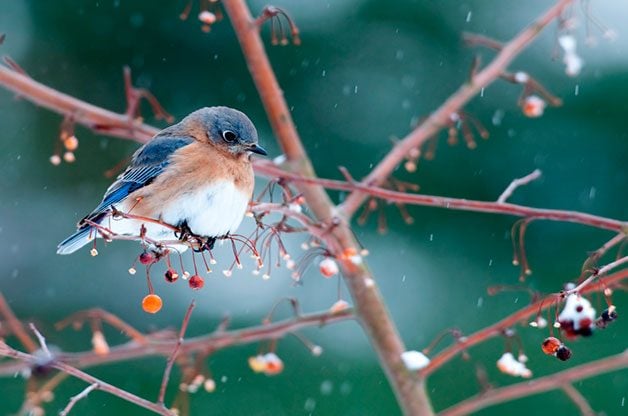For those longing for a spectacular landscape past the traditional summer display of flowering plants, plenty of options abound. Show-stopping trees, seasonal shrubs and fall-blooming perennials can bring a burst of autumn color to your yard, as you relish the shorter, cooler days. All it takes is a little forward thinking and knowledge about the basics of fall leaf colors.
1. Fall Leaf Colors: Do Your Research
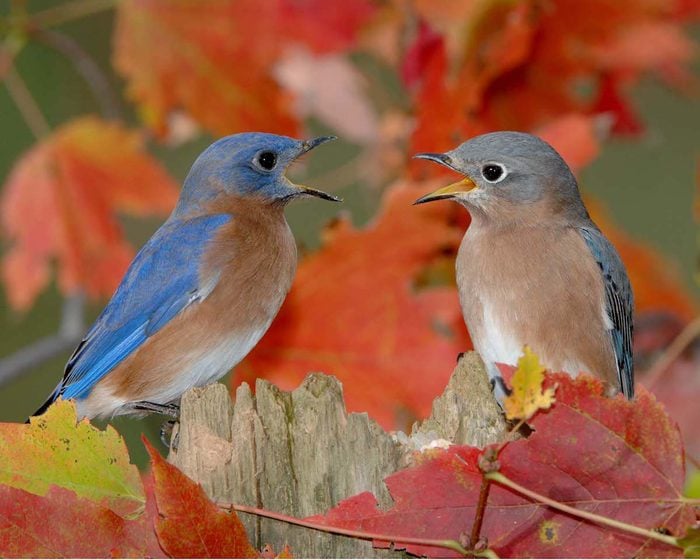
It only makes sense to choose plants known to have great fall leaf colors…ones that harbor vivid pigmentation under their green hues until cooler temperatures unleash their fall potential.
But how do you find them, especially since you’re going to buy the plants during the growing season, when they don’t show a hint of their autumn leaf colors?
Do a little homework first. Find out which plants have the best autumnal shows. Ask at the nursery, check plant tags, surf the Internet, and consult reference books or catalogs. If the plant has fall foliage worth praising, it’s sure to be mentioned in one of all of these places.
Another, more informal way is to talk to your neighbors, especially the ones who have fall landscapes you’ve admired. Ask if they can identify their fall beauties by variety, or at least direct you to the nursery where they purchased them. The advantage to this method is that you’ll already know the plant thrives in your area and shows lots of color.
Check out the top 10 easy-to-grow native plants.
2. Think Trees

Whether you’re starting your landscape from scratch or updating an existing one, there are several types of plants that will award you with autumnal glory. For many, Mother Nature’s most spectacular show is when native trees finish out the growing season in a brilliant display of fall hues. So why not follow her cue and plant some in your own yard?
Autumn, with its milder temperatures, is the perfect time to plant young trees while you’re enjoying the display of more established ones.
Whether you prefer the ginkgo’s glorious yellow foliage or the brilliant orange display of the sugar maple, there’s a tree out there with the color you crave. Some even turn multiple colors, like the sweet gum. This unusual tree follows a progression of color—first yellow, followed by orange, then red and, finally, deep purple.
Check out the top 10 trees and shrubs with berries for birds.
3. Seek Out Sensational Shrubs

Shrubs may be the best way to fire up the fall landscape. They grow on a smaller scale than trees and are admired at eye level. Their size also means it’s easier to find spots for them in an existing landscape, and they won’t create unwanted shade. As an added bonus, you get to enjoy their spring and summer appearance before they take center stage.
And when they do leap into the autumn spotlight, dazzling us with vivid foliage, glorious berries or even remarkable flowers, it’s as though you’ve suddenly discovered an old friend’s hidden talent!
Check out the top 10 small shrubs for small spaces.
4. Plant Perennial Favorites

Who can resist the head-turning charm of chrysanthemums…the carefree look of goldenrod…or the colorful allure of an aster?
Fall-blooming perennials are a terrific way to liven up an end-of-the-season garden. Most are hardy and their dried seed heads provide interest in the winter landscape (as well as nourishment for the birds).
Plants, such as ornamental grass or the rose hips from spent shrub roses, provide more than just color—they also offer architectural elements that give the autumn garden added interest.
Check out the top 10 edging plants for three seasons of color.
5. Choose Your Favorite Fall Leaf Colors

Autumn is all about color. So when considering it, think flowers and foliage. While both can set the scene, dazzling foliage usually spans the seasons. Barberry, native grasses, burning bush and white ash are just a few of the plants whose foliage deserves an end-of-the season standing ovation.
Turn up the heat. “Hot” autumn leaf colors, like reds, yellows and oranges, are familiar sights in the fall. These bold hues stand out in the flower bed, making the plants that boast them appear larger and closer than they are. Since these rich jewel tones effectively absorb the autumn sunlight, the intense effect make plants like sedum look more like stained glass.
6. Dare to be Different

One of the biggest joys in savoring autumn is discovering the surprises least expected. Sometimes, the placid purples and brazen blues of ornamental kale and cabbage steal the seasonal scene. Cool hues among “hot colors” contrasts between vibrant leaves and evergreens. Ornamental grasses that boast metallic-blue blades, topped by reddish brown cloud-like plumes, are out-of-the-ordinary fall pleasers.
Don’t miss these 9 fun fall outdoor container ideas.
7. Add Evergreen Backdrops

Dark-green conifers or an arborvitae or laurel hedge make a beautiful dark wall behind colorful shrubs. Yellow or multi-hued fall displays look better than dark reds when planted against evergreens.
Check out the best types of evergreen trees and how to care for them.
8. Find the Right Spot

The time to think—and dream—about autumn leaf color colors is in the fall. Walk around your property as the gardening year winds down and take a long, hard look. Where do you need lively, brilliant color? Where would it be welcome?
Fall cleanup: 8 garden chores you should never skip.
9. Strength in Numbers

Plant brilliant shrubs and fall-blooming perennials in groups, either in small gatherings or as a long hedge. When joined together, they make a much bolder statement.
Psst—grow these late-blooming fall flowers that attract butterflies.
10. Solo Leaf Color Shines

When sited in the middle of a lawn or set off from similar-size plants, some plants, especially larger shrubs and ornamental trees, look spectacular in the fall. This is especially worthwhile if your plant of choice forms a handsome profile. The lowering autumn sun can sometimes cause some dramatic “backlighting” effects, especially in the evening hours.
When it comes to fall cleanup, the work can add up. Judy Roberts of Graytown, Ohio, even jokes, “My list includes emptying pots and storing them, digging up calla lily tubers and removing all my ceramic garden décor. Phew—I’m tired just thinking about it!”
But, some fall cleanup chores are more important than others to keep your yard and gardens looking fantastic. They also set yourself up for success through winter and spring. Here are the tasks that Birds & Blooms readers never skip, no matter how busy they are.
1. Fall Cleanup: Take Care of Garden Tools

It’s possible for plants to swap diseases and parasites, but there are a few things you can do to help keep your plants healthy. One can’t-skip autumn activity is cleaning and sharpening garden tools.
“I’m sure to clean all my garden utensils thoroughly,” comments Joan Heid of Chester, South Carolina. She adds that it’s also a great time to organize them, saying that she always “stores tools away for easy access in spring.” Wipe tools clean of any sap, soil or dirt. If you’ve used a tool on a diseased plant, be sure to soak it in a 10 percent bleach solution and rinse well with clear water. Allow the tool to dry thoroughly before storing it away to avoid rust. Also replace any worn out or damaged tools.
Looking to upgrade your equipment for the next gardening season? Check out these essential tools for fall garden cleanup.
2. Dig Up Non-Hardy Bulbs

Fall is the time to get down and dirty. Some plants grow well outdoors in the summer, but just can’t take the winter cold. Non-hardy bulbs like dahlias need to be dug up and stored for winter and then replanted in spring.
Here’s how to find the first and last frost dates.
Lifting plants generally involves digging them up carefully, ridding them of excess dirt, allowing the bulb or tuber to dry out, and storing carefully in a cool dry place for the winter (garages are often ideal, but protect your treasures from mice).
“I dig up the amaryllis bulb that I planted in spring and place it in a bag in a dark area to grow again later,” says Holly Ferkett of Pittsburgh, Pennsylvania.
Fall is also the best season to plant spring blooming bulbs like daffodils and tulips.
Psst—learn everything you need to know about planting and growing dahlias.
3. Mulch Fall Leaves

Mulch serves a few purposes in the garden. It can hold moisture in the ground (so you can water plants less often!) and even improve the soil quality.
Fallen leaves make excellent mulch for your lawn. So don’t bag them up and throw them away. Lisa Malmberg of Green Bay, Wisconsin, says, “After gardening organically for more than 30 years, I mulch all our beds with shredded leaves each autumn.”
To do this fall cleanup chore yourself, just run a pile of leaves over with a lawn mower. The leaf mulch will be ready when the leaves are in quarter-sized pieces.
Lisa points out other benefits, too. She says, “It’s great for the plants and soil, and birds love all the insects they find in the leaves.”
We asked a garden expert: Can you reuse potting soil?
4. Turn Over the Soil
It’s a hard job, but Pam Soetaert of Lampe, Missouri, says, “I turn soil over in the fall because I’m six months younger than I will be the following spring!”
Check out 25 more garden tips we learned from our grandmas.
5. Create Brush and Yard Debris Piles

Piles of branches, sticks and other yard debris can be worth their weight in garden gold. These piles can be used as compost, broken down into mulch, or serve as a home to helpful backyard bugs.
Greg Mandigo of Alma Center, Wisconsin, says, “Along with disease- and insect-free garden debris, I make a pile of leaves in my yard. In spring, I use this mulch to cover potatoes and put around my plants.”
Learn how butterflies and bugs hibernate.
6. Store Garden Hoses
Drain your garden hoses and bring them in when you’re done, since water left in hoses over winter can lead to cracking and bursting.
Check out the best fall flowers (that aren’t mums).
7. Protect Your Roses
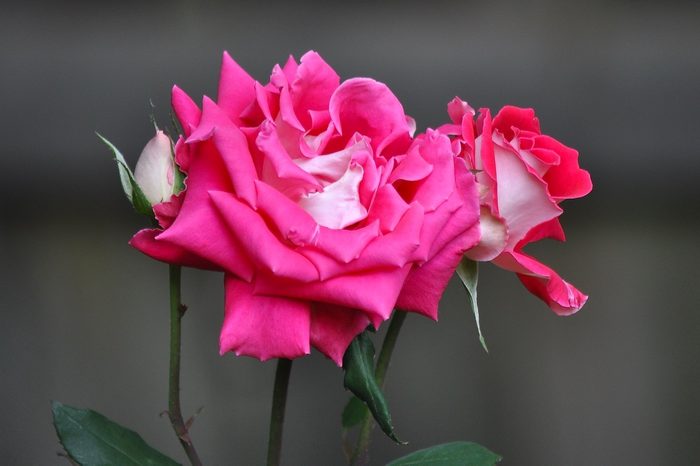
If you’re a rose gardener, this is one of those fall cleanup garden chores that goes without saying. But if you’re new to growing roses, or have a special rose bush you’d like to protect, this chore is worth a few minutes of your time. Trim tall canes and cover roses with straw or evergreen boughs to protect the plants from cold weather.
If you use rose cones, make sure they are vented. You can also cover roses with dry leaves and wrap them with hardware cloth or burlap. Before covering roses, clean up any diseased leaf debris and apply a new layer of mulch to your beds.
8. Mark Plant Locations
Now’s the time to use sturdy plant markers to note the location of any new perennials, bulbs, or seeds you might forget about come spring. There’s nothing more frustrating than accidentally weeding out seedlings in the spring along with pesky weeds, or planting something on top of something else without realizing it.
There’s no need for anything fancy. Try a permanent marker and paint stir stick, topped with a coat of clear gloss spray enamel. You don’t need it to look pretty. You just need it to last until spring.
Discover why fall is the perfect time to plant perennials.
As the weather gets chilly and the air crisp, autumn birds like woodpeckers, chickadees and robins visit backyards for food and shelter. And each year, our readers share their favorite snapshots of the fall birds that touch down in their own backyards. We rounded up a collection of our favorite autumn bird photos.

Tufted Titmouse
“An adorable tufted titmouse enjoyed some corn at a feeding station in Dorothy Carnes County Park near Fort Atkinson, Wisconsin. I don’t have titmice at my own feeders very often, so I was thrilled to spend some time with this little cutie,” says Barbara Houlihan of Madison, Wisconsin.
Did you know: Tufted titmice join small flocks of birds, including chickadees, nuthatches and woodpeckers in the winter months. Also, if you’ve ever heard them referred to as “titmouses”, learn about the correct plural terminology.

Pine Siskins
“On a cold, rainy October afternoon, our feeders were overwhelmed by a flock of pine siskins. We had seen one of these birds in the yard a couple of times, but this was wild! The competition for food was fierce among the many birds. They kept snipping their beaks at one another, protecting their snack supply. I got a number of entertaining action shots from this group of aggressive autumn birds,” says Ginger Culp of Gurnee, Illinois.
Pine siskin vs goldfinch: Here’s how to tell the difference.

Barred Owl
“It was such an honor to watch this barred owl all afternoon in a tree behind my fence. The bird had a nice, lazy Sunday while posing for my camera. It didn’t seem to mind me at all,” says Jennifer Rush of Gresham, Oregon.
Learn how to spot the owl in your backyard trees.

Eastern Bluebirds
“I was enjoying a sunny, refreshing fall morning when a family of eastern bluebirds showed up. After they romped around the treetops for a while, I went inside. When I came back out, they were checking out this bird house. I think they wanted to put down a deposit for next year!” says Kimberly Miskiewicz of Raleigh, North Carolina.
Don’t miss 20 beautiful pictures of bluebirds.

Black-Capped Chickadee
“A black-capped chickadee was getting ready to dive onto my feeder. Although they are small and super common around my neighborhood, they’re still among my favorites,” says Raven Ouellette of Sudbury, Ontario.
Check out 20 incredibly cute chickadee pictures.

American Robin
“A flock of American robins landed on a large beautyberry bush in my backyard in November. I enjoy this image, which I used a Nikon telephoto lens to capture, because of the colors and pose of the bird,” says Darryl Neill of Decatur, Georgia.

Blue Jay
“Blue jays showed up in my backyard regularly after I filled this little pumpkin with seeds,” says Victoria Schwinabart of Swanton, Maryland.
Check out more beautiful blue jay photos you need to see.

Ruby Throated Hummingbird
“I took this photo during fall migration in Iowa. The painted lady butterflies were migrating and my flowers were covered with them. This hummingbird gave up trying to chase the butterflies away and decided to just share the flower with the butterfly,” says Linda Petersen.
Discover fascinating facts about fall hummingbird migration.
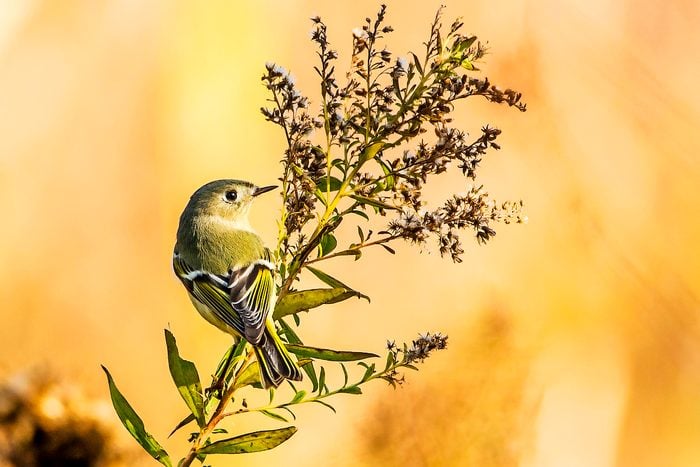
Ruby Crowned Kinglet
“I love the way the colors on the plant match the bird, and how this ruby crowned kinglet that is normally moving nonstop paused just long enough for me to capture this photo of it against the soft orange background. It was November, and the colors in this photo are the colors of autumn—my favorite season!” says Laura Frazier.

Bald Eagle
“I was enjoying photographing the gorgeous fall foliage at my home in northern Minnesota when this amazing bald eagle flew near me, then struck a pose as though he was just waiting to be photographed. I live on a lake where the eagles build a nest every year, so the eagles have become treasured backyard neighbors. It’s just incredible to watch these majestic birds raising new families every year,” says Debbie Center.
We found 7 amazing nature photos you won’t want to miss.

Palm Warbler
“I took this photo at Middle Creek, which is 20 minutes from my home. I believe the bird in the photo is a palm warbler. To me it looks like a painting and as if the bird posed for it. It is peaceful and relaxing,” says Janet Zimmerman. Fall ID tips: blackpoll warbler vs bay breasted warbler.
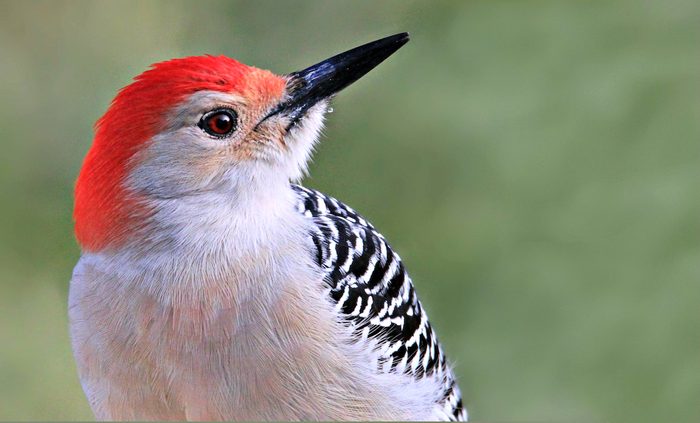
Red-Bellied Woodpecker
“This handsome bird visits my feeder in late fall and winter. It is one of my favorite visitors and always brings a smile to my face. I love the vocals on the red-bellied woodpecker,” says Sherry Nicholson. Check out the 4 best foods for attracting woodpeckers.

Mute Swan
“Fall colors reflected in the water make it look like this mute swan is swimming in a golden pond at Stanley Park in Westfield, Massachusetts. The swan is a perennial resident of the park,” says Marc St. Onge. Check out 6 romantic and fascinating swan facts.

Cedar Waxwing
“This shot of a cedar waxwing was taken in my yard with a Nikon D3100 and a 300 mm lens. Every fall these beautiful birds visit the area, and I was lucky enough to witness this scene one morning as they ate berries from one of my viburnums. This photo is special to me because it’s a once-in-a-lifetime snapshot of a gorgeous bird,” says Patricia Warren. Where do waxwings go in winter?
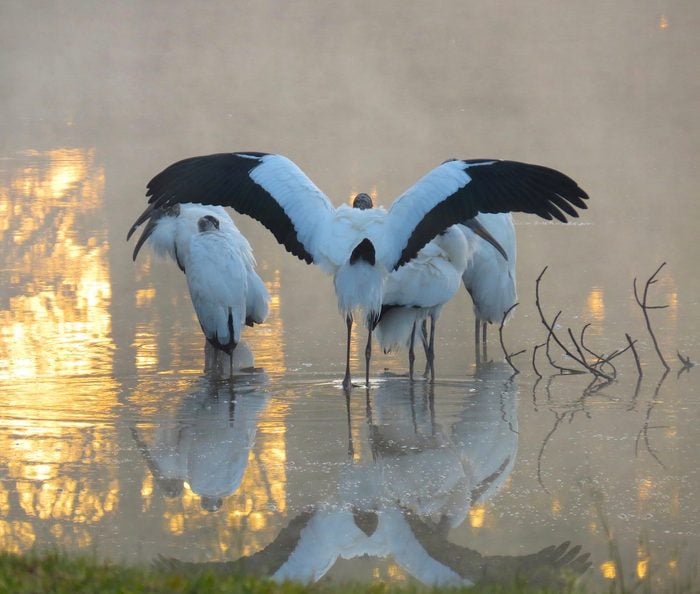
Wood Stork
“We’re lucky to have several wood storks who call our backyard home. This was shot with my Canon SX-50 at sunrise on a lovely fall morning. With wings wide spread; the main character in this photo seems to be holding court! The reflections and ever-changing colors at the lagoon always serve as a beautiful backdrop for the many wading birds that visit us here in the South Carolina LowCountry,” says Elizabeth Angelone.
Check out 20 black and white birds you might see.
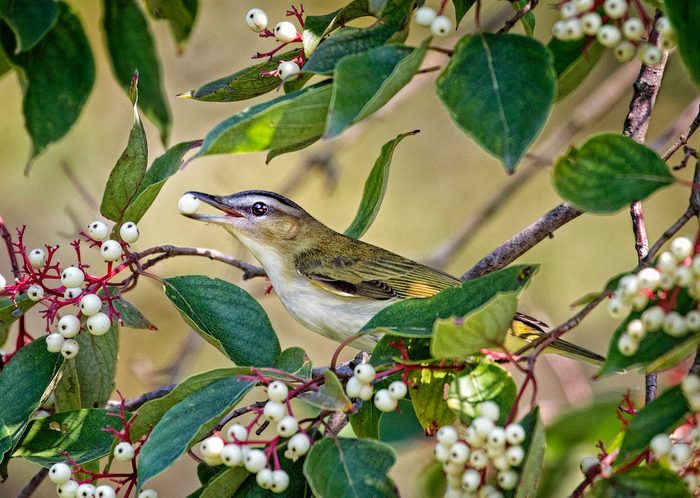
Red Eyed Vireo
“I took this photograph in Lake County, Illinois, during fall migration. There were many autumn birds feasting on the dogwood berries including this beautiful red-eyed Vireo. I love this photograph because I managed to capture the bird with a berry in its bill and I like how it is framed by the foliage on this native shrub, says Emma England.
Meet the vireo bird family: sweet summer singers.
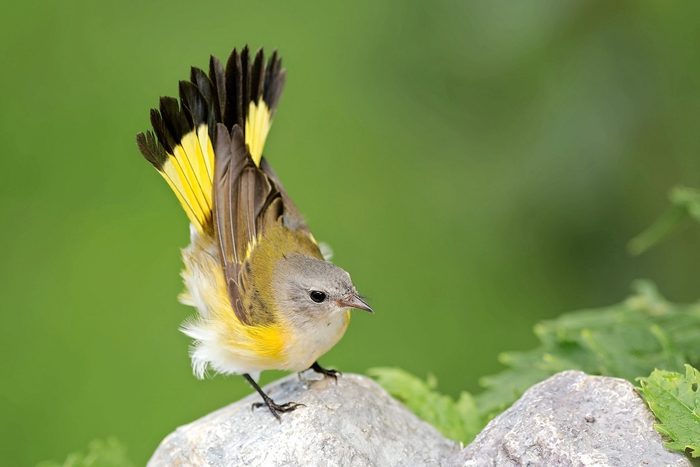
American Redstart
“This was taken last fall during migration. I was in my backyard taking pictures of autumn birds when this female American redstart appeared at my water fountain. She was very excited to see water and kept hopping back and forth, fanning her tail feathers trying to get brave enough to jump in,” says Linda Petersen.
Don’t miss the 51 best winter bird photos.

Red Shouldered Hawk
” I was raking leaves in the fall at my mother-in-law’s home in the country near Butner, North Carolina, and this red shouldered hawk flew by. So I grabbed my Canon T3 out of the car and locked on to get several shots. In this one he lit nearby so I had time to open the aperture and take advantage of the light. The resulting clarity of the hawk’s plumage was what made this photo so special,” says Lon Paulson.
Check out 5 essential hawk identification tips for birders.
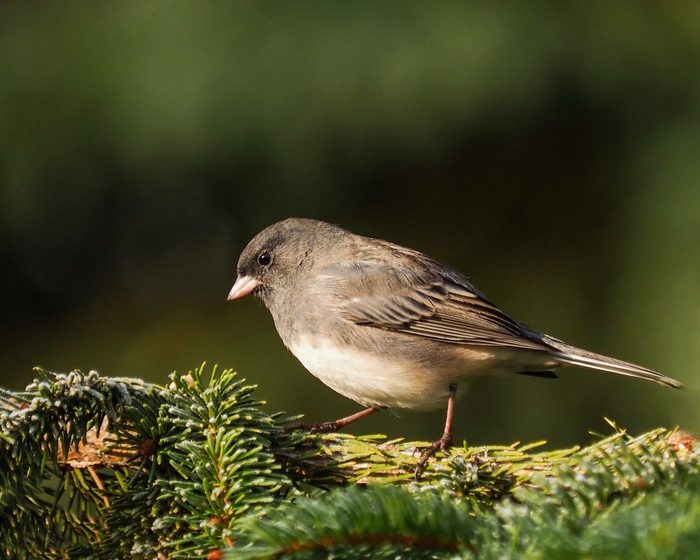
Dark-Eyed Junco
“I really enjoy trying to get photographs of autumn birds. These little dark-eyed juncos fill our backyard late fall thru spring. I like the light frost on the pine branch,” says Jessie Buckholz.
Learn how to attract more juncos to your backyard.

Steller’s Jay
“This photo is a Steller’s jay near Bailey, Colorado. These striking birds are frequent visitors to my sunflower seed and suet feeders virtually year around. This photo was taken in October, when the aspens were in peak color,” says Michael J Quaintance.
Meet the 8 types of jays you should know.

Costa’s Hummingbird
“This photo was taken in the fall during a visit to the Phoenix, Arizona area. While visiting a local park to go birding, I noticed this male Costa’s hummingbird feeding among the flowers. It was a bright, sunny day, which allowed a fast enough shutter speed to freeze the hummingbird in flight,” says Hayley Crews.
Check out 35 stunning hummingbird photos you need to see.

House Wren
“Each morning I walk a different preserve, natural land or park. Usually my camera and two dogs are with me. On this beautiful day in early October I was at the Tyler arboretum. This is one of the few places where no dogs are allowed, but it gives me more freedom. I like this photo of the house wren among the berries,” says Theresa Erbstein. What does a Carolina wren call sound like?
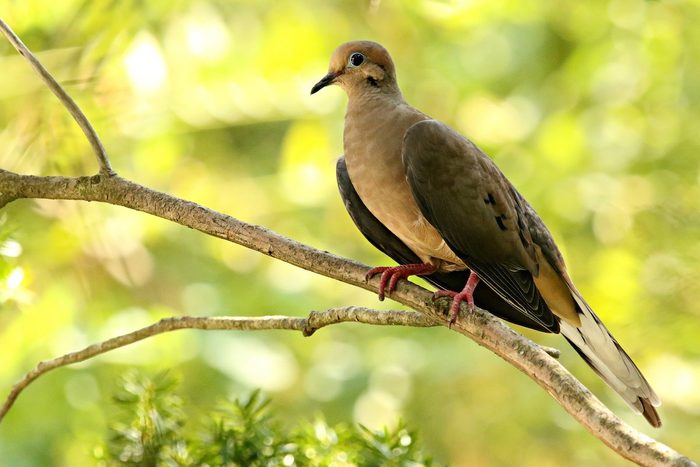
Mourning Dove
“On a late summer day, I looked out my living room window to see a mourning dove perched on the tree. The light filtering down on the bird was just gorgeous, so I grabbed my Canon EOS 7D Mark II and quietly headed out my back door to take the shot. I find mourning doves to be such beautiful, peaceful creatures, and this heavenly light just accentuated that for me,” says Patricia Welch. Check out more breathtaking photos of mourning doves.
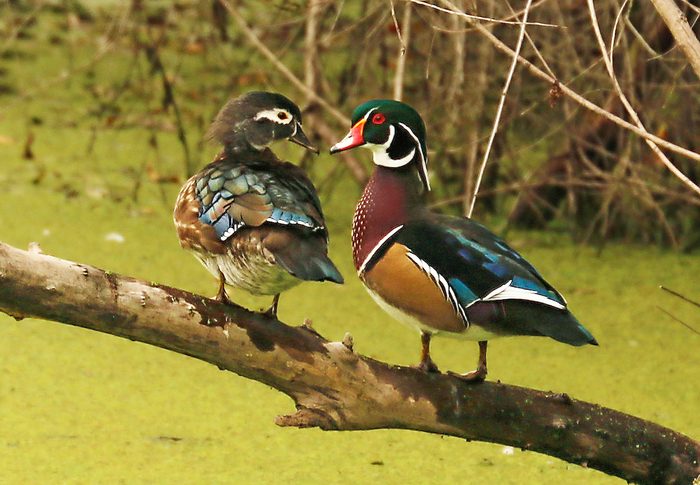
Wood Ducks
“I photographed this pair of wood ducks on a small pond near our home. I’ve provided two wood duck nest boxes that have been used for the past 11 years. I took the photo with my Canon EOS 70D,” says Edward Price of Rocklin, California.
Did you know: Wood ducks, both male and female, have blue and white wing plumage.
What foods can you feed to ducks?
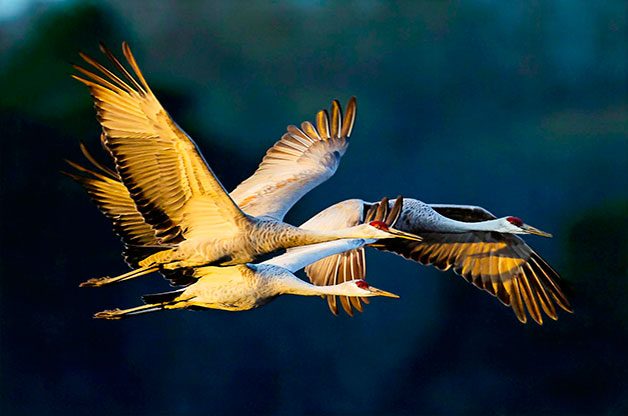
Sandhill Cranes
“Every autumn I eagerly look forward to the annual migration of sandhill cranes through southeastern Tennessee. Most years, it’s October when I hear the distinct throaty call of cranes flying overhead. The weary travelers rest for a couple of months at the Hiwassee Wildlife Refuge near Birchwood, Tennessee, where I photographed these autumn birds in flight. It’s a thrill to observe them during their short visit,” says Dan Sommers, Chattanooga, Tennessee.
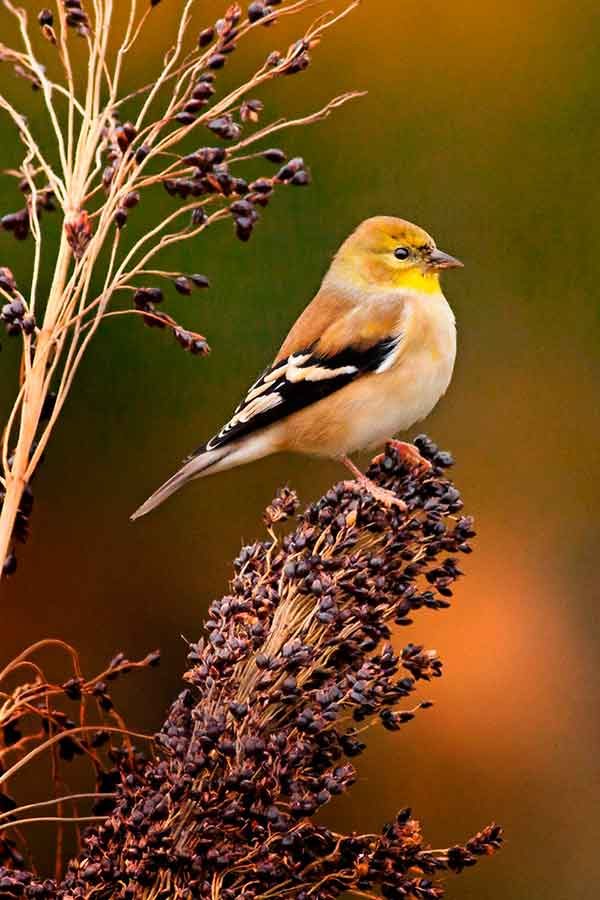
American Goldfinch
“While picking out pumpkins, I saw some broom corn and decided to hang it up near my backyard feeders. The American goldfinches, which had been absent for about a month, quickly came back to eat the seeds and use the broom corn as a perch while waiting for the feeders. It certainly made for a beautiful photograph of autumn birds,” says James Prutilpac, Morgantown, West Virginia. Here’s how to attract more goldfinches to your backyard.
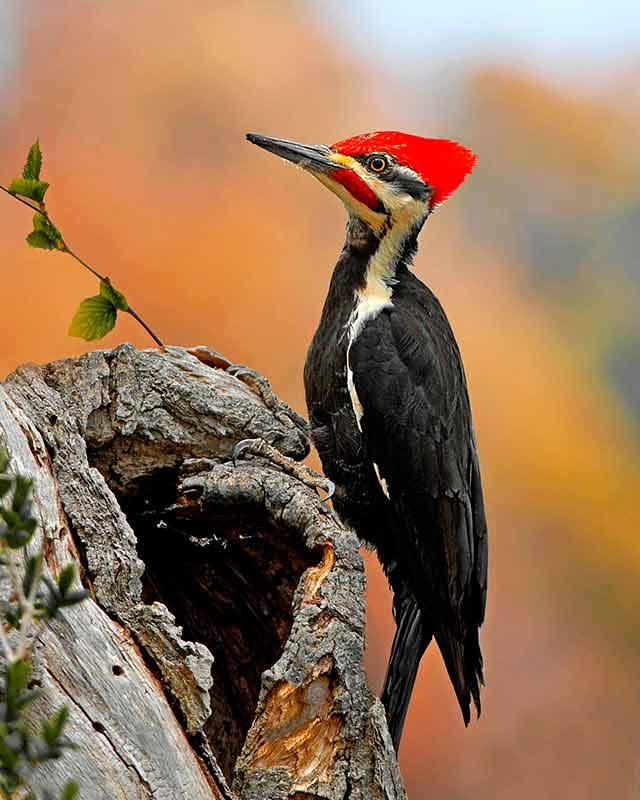
Pileated Woodpecker
“This pileated woodpecker landed on a stump near my home and immediately began searching for food. A close look at its beak shows a small insect it found. I was glad I had my Nikon D300 with me so I could get the shot before the woodpecker took off. A friend witnessed the scene and could not believe the bird landed so close to me,” says Tom Lusk, Lansdowne, Ontario
Did you know: The easiest way to spot woodpeckers is to use your ears. Listen for their quick tapping on dead trees as they hunt for insects.
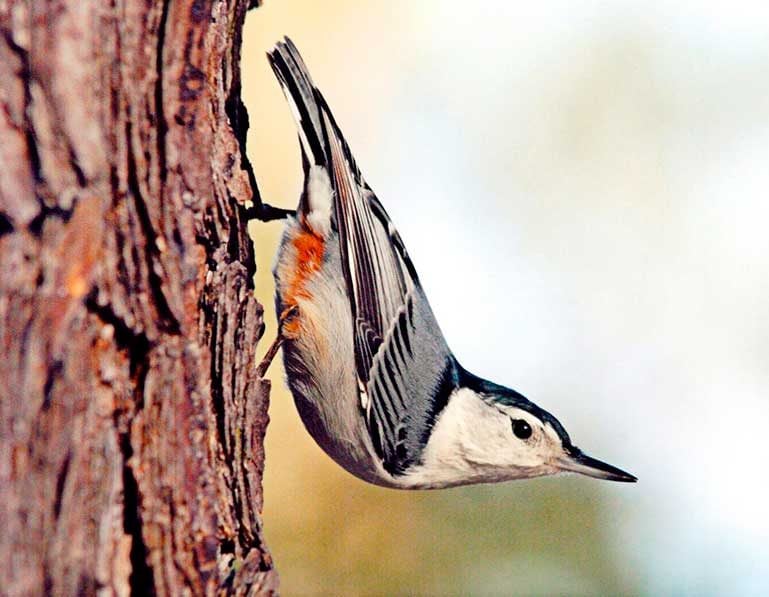
White Breasted Nuthatch
“A white-breasted nuthatch hopped down a longleaf pine tree right in front of my farm truck. I sneaked over with my camera, leaned against the truck and waited for the right moment. I wasn’t disappointed,” says Roger Stranc, Rembert, South Carolina.
Did you know: In winter, white-breasted nuthatches trade insects for seeds, like acorns and pine nuts, and eat a mostly vegetarian diet.
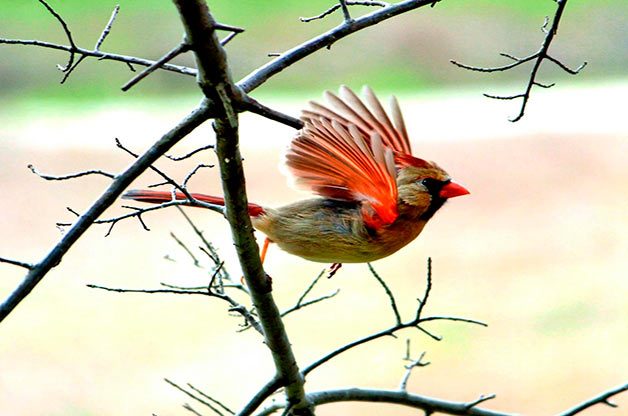
Northern Cardinal
“I adore cardinals, especially in fall and winter. This female landed in a nearby dogwood tree, and I immediately focused the camera on her. I was almost afraid to hope for a photo of her taking off, but I kept my arms and hands steady despite my nervousness. As she spread her wings in the morning sun, I held my breath and started snapping. The final result completely made my day,” says Vera Walling, Orangeburg, South Carolina. Check out more simply stunning photos of cardinals.
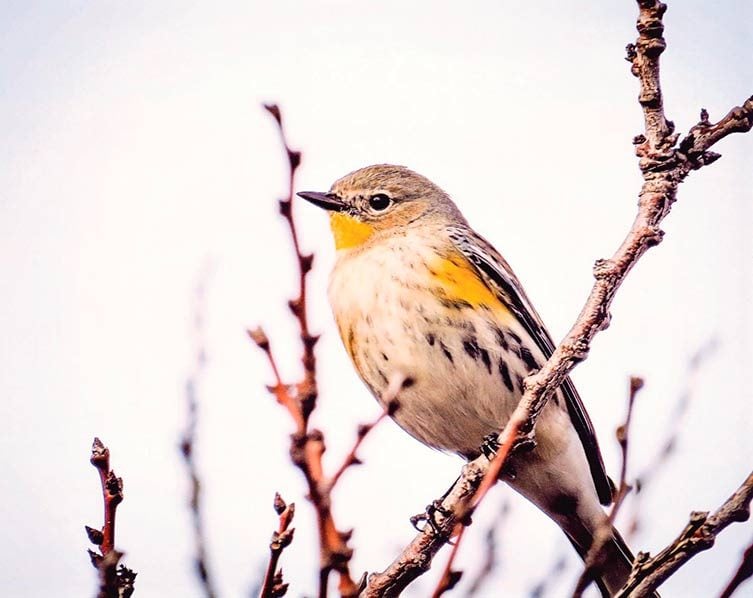
Yellow Rumped Warbler
“I have transformed my backyard into a bird sanctuary, including finch feeders, hummingbird feeders, a bird bath—you name it! Never in my wildest dreams did I think I would attract such a large variety of birds, though. Bushtits, black phoebes, Nuttall’s woodpeckers, orange-crowned warblers and Anna’s hummingbirds have all stopped by. But the one bird I can’t get enough of is the yellow-rumped warbler. It doesn’t come around often and is very shy and difficult to photograph. I was very lucky to have gotten this photo of it,” says Sheralyn Maddock, Rancho Palos Verdes, California.
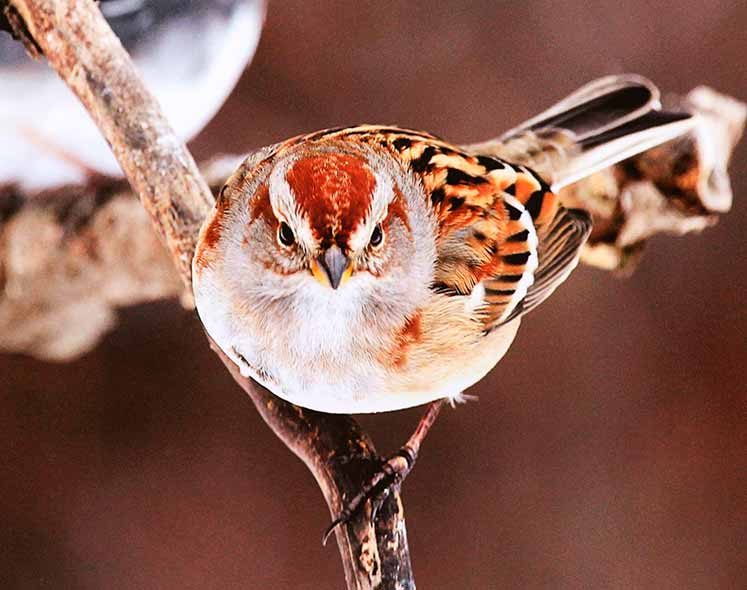
American Tree Sparrow
“These autumn birds seemed to be waiting for my husband and me. As soon as we came home, they flocked to the feeders. As I snapped a few photos, this American tree sparrow looked right at me as if to say, “It’s about time you got home! I’m starving!” My favorite thing about this species is their gray bushy eyebrows, which remind me of a grandfather’s. I call these cute, pudgy birds ‘old man sparrows, ‘” says Susan LoParco, Cortland, New York.
Every season brings tasks that backyard birders can do to encourage more birds to visit. Read on for easy ways to ensure great fall bird-watching in the months ahead.
Here’s how to plant a gorgeous fall garden your birds will love.
On This Page
Offer High Protein Options to Migrating Birds
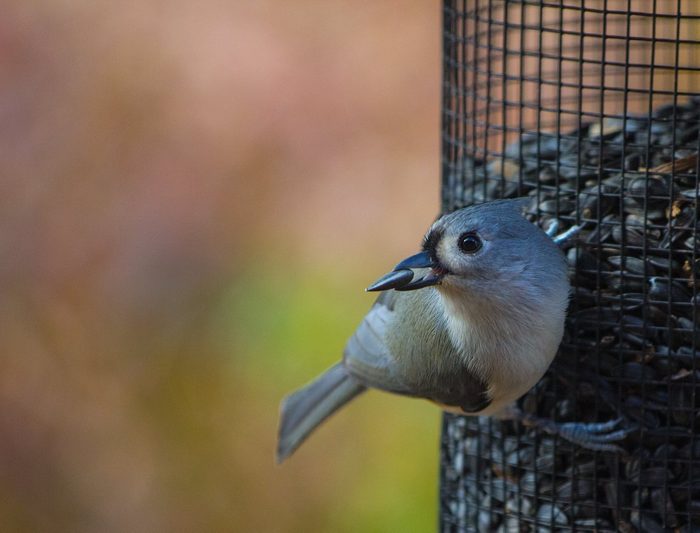
Stockpile all types of sunflower seeds. These offer the greatest amount of energy for the birds of fall and winter.
“I offer high protein foods like peanuts (both shelled and unshelled), suet, sunflower hearts and thistle seeds,” says Mindy Drexler of Canal Fulton, Ohio.
Provide Fresh Water
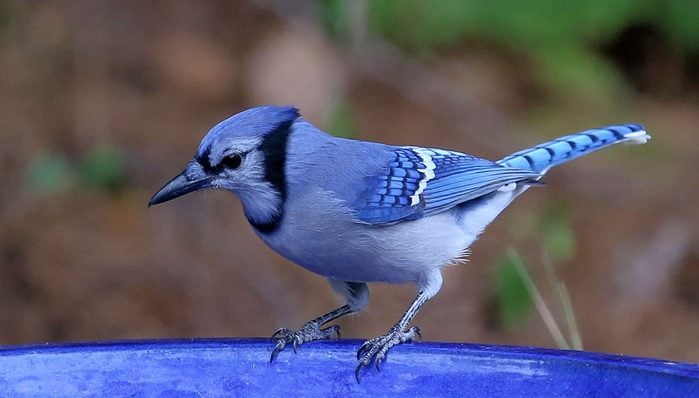
Birds that are migrating south need water to both refresh themselves and keep their feathers in good shape for smoother flying. An electric birdbath heater may be used to attract thirsty birds.
“Along with food, provide a water source,” says Judy Roberts of Graytown, Ohio. “Add a heater to your bird bath so it doesn’t freeze.”
Learn how to help birds in cold winter weather.
Switch to Fall Bird Feeders
For the best chance of attracting the widest variety of local and migrating birds, be sure to use multiple feeders. Switch to hopper-style feeders, which are more practical than tray feeders at times when the moisture from rain and snow can ruin food. Tube feeders work well in inclement weather, too.
Tube feeders attract fliers such as finches, sparrows and titmice; hopper feeders are shaped like little buildings, with a roof that protects seed and perches where birds like northern cardinals, grosbeaks and mourning doves can sit and eat.
Hang Up Suet Feeders

In the North, switch exclusively to suet and a few types of birdseed, as the birds that enjoy insects have gone south for the winter. Double the number of seed and suet feeders around your yard, as birds are currently flocking and there are many more mouths to feed. Woodpeckers and chickadees like to cling to suet feeders.
“I put out extra suet feeders for birds to fill up on during their migration stopovers,” says Christina Lorenzen of North Babylon, New York.
Check out homemade suet recipes for feeding birds.
Keep Hummingbird Feeders Up
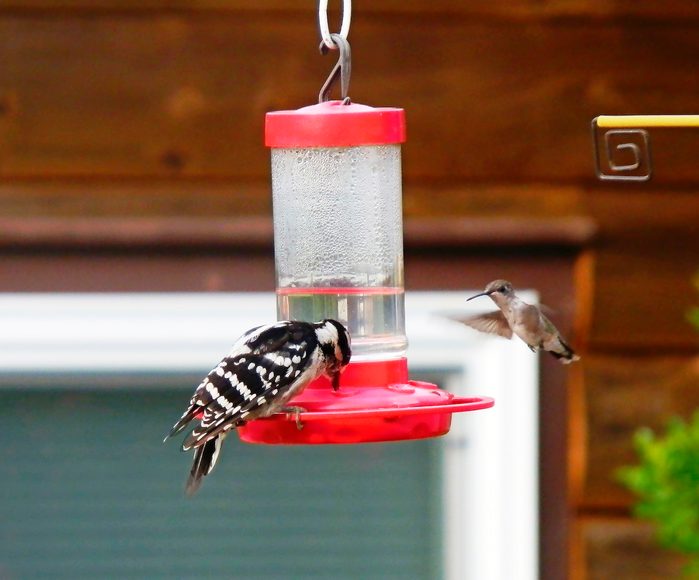
Orioles, hummingbirds and tanagers count on plenty of fruit, flowers and feeders on their way south, so they’ll likely stop for a sip of sugar water served in an oriole or hummingbird feeder. (Learn how to make your own sugar water for hummingbirds.) Keep feeders up until late fall. You never know what stragglers might pass by, and they’ll really appreciate the energy boost.
After the last of the orioles and hummingbirds have passed through your area, remove and clean all sugar-water feeders.
Practice Good Bird Feeder Maintenance
Check the condition of bird feeders and squirrel baffles to make sure they will make it through the winter. Clean your feeders and replace the ones you can’t repair. Protect stored bird food by securing it in waterproof garbage cans. Place bricks or bungee cords on top of lids to keep out raccoons and squirrels.
Check out the best squirrel-proof bird feeders and 12 tips that work.
Plant Berry Bushes

“Autumn birds that are ready to migrate are attracted to the berry bushes I have scattered throughout my yard,” says Liza Peniston of Augusta, Kansas. “As a plus, you don’t have to spend money on birdseed!”
Learn how to attract cedar waxwings.
Don’t Pick or Mow Spent Flowers
“I let dandelions grow in the fall and winter,” says Linda Taylor of Woodway, Texas. “Goldfinches visit them and eat their tiny thistlelike seeds.” Also leave up spent perennials so birds can eat the seeds.
Psst—watch your fall feeders for a red breasted nuthatch.
Stop Raking Leaves and Make Brush Piles
During your fall yard cleanup, collect woody plant clippings to create brush piles. These will protect ground feeding birds and other wildlife. Plant a few evergreen trees and/or shrubs around feeders to help birds hide from predators, and to offer security during cold winter nights.
“Leave the leaves!” says Beth Sullivan of Southaven, Mississippi. “Leaf litter provides a home for insects and small animals, and autumn birds are attracted to the bugs and seeds in the piles.”
Next, check out the best foods to feed birds in winter.
All About Suet for Birds

Fall offers lots of fantastic bird-watching opportunities. Leaves begin to drop, making it easier to see treetop visitors, and it’s finally cool enough to set out a favorite treat: suet for birds. A high-fat, protein-packed offering, it attracts both insect-eating species and omnivores, all while providing the perfect amount of calories to help birds flourish in colder weather.
“At different times of the year, birds need different nutrients,” says Ken Elkins, the community conservation manager for Audubon Connecticut. “Suet can start to be valuable to birds in the fall, not just the winter.”
And while suet is tantalizing for birds, it’s great for bird-watchers, too, as it brings new species to your backyard for a closer look. “Suet is one of those feeding experiences where it keeps them there, in view, a little longer,” Ken says.
Ken notes that the suet you serve won’t replace a large part of a bird’s diet; the birds are still going to find a lot of natural food around them. He says, “If you are really trying to attract a diverse group of birds, think about having plants in your backyard to provide the foods they need throughout the season and to attract more insects.”
Get the answers to commonly asked questions about serving suet for birds.
1. What Is Suet for Birds?
From a technical perspective, suet is specifically the raw fat around kidneys and loins, mostly in beef. Because it’s high in fat, it gives birds lots of energy, which is especially helpful in cold weather. While suet is typically made from rendered animal fat, some bird food suppliers make plant-based options with vegetable shortening or nut butters. The fats are mixed with seeds, oats, fruits, mealworms and more—all ingredients you can try out in your own recipe at home.
Check out proven tips for attracting birds with suet.
2. What Are Suet Cakes for Birds?
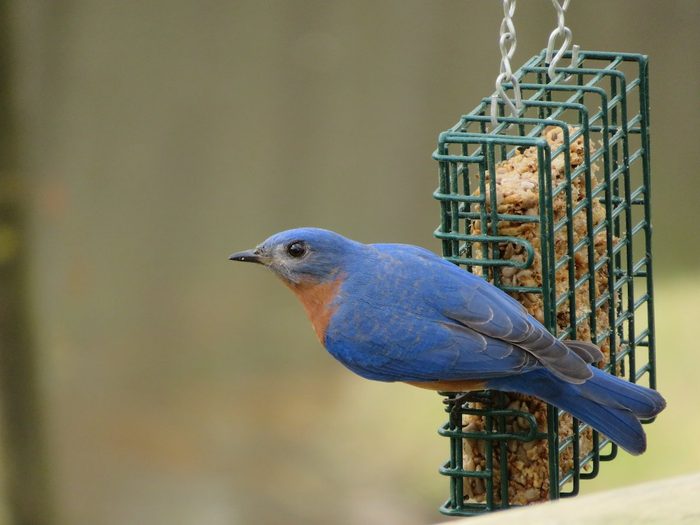
Suet cakes are actually what most people refer to as suet. They are square shaped blocks usually made up of a mixture of things, including suet (or rendered beef fat) as a primary ingredient. Other ingredients in suet might include peanut butter, peanuts, birdseed and cracked corn.
Learn how to make birdseed suet cupcakes.
3. Should I Make Suet or Buy It?
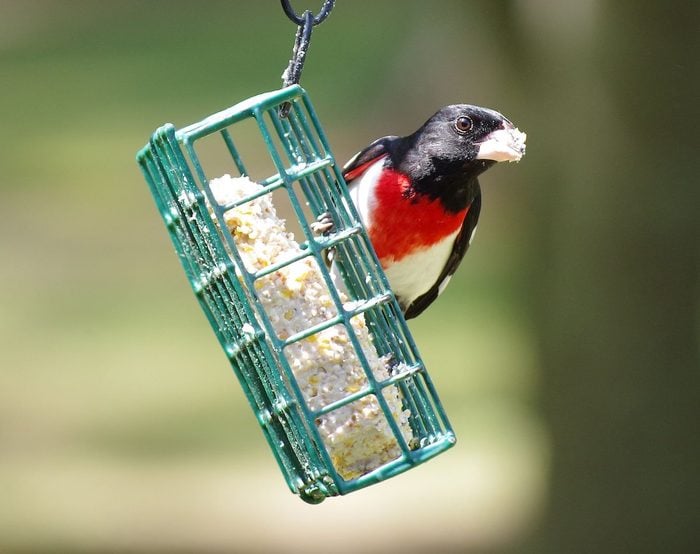
Whether you make your own or buy it from a store is up to you. When buying suet cakes from the store, shop local or from family-based suppliers so you can ask questions regarding their ingredients and melting temperatures. Be sure to also check the ingredients for palm oil, as palm oil plantations cause deforestation, affecting wild birds and other wildlife globally.
Of course, suet should have actual suet (or rendered beef fat) listed as an ingredient. If you want to make your own, hit up your local butcher shop and ask them to buy the suet. It should be fairly inexpensive, and you can be sure it’s what you need for the birds.
Great suet is all about the right consistency. A good base is 1 cup of suet and 1 cup of peanut butter. (It’s a myth that birds will choke on peanut butter, so don’t hesitate to include it!) Melt over low heat, and mix in 1/2-cup of cornmeal and 1/4-cup of oats. Next, add 1/4-cup of items like birdseed, nuts or berries. Freeze in muffin tins or small containers until you’re ready to use it. Check out more homemade suet recipes.
4. What Is the Best Way to Serve Suet to Birds?

In the simplest form, you can just smear suet onto a branch or a hollowed log—no special feeder required. Another option is a cage feeder, which you can pick up for a few bucks. This definitely does the trick without spending a lot of money. Finally, if you want to maximize your real estate, look for a special suet feeder that will hold several suet cakes or blocks at once.
5. Where to Hang a Suet Feeder
When it comes to placement, hang suet in a visible area about 10 to 12 feet from shrubs, trees or another protected perching spot. For feeders with windows nearby, remember to place the suet either within 3 feet of the glass or farther than 30 feet away to keep birds safe from potential collisions. Also, think about what animals live in your neighborhood before you decide where to place your feeders full of homemade goodness.
Check out the 10 types of bird feeders you need in your backyard.
6. What Birds Eat Suet?
You can attract a wide range of birds that eat suet, including chickadees, nuthatches, wrens, thrushes, creepers, thrashers, jays, and nearly all woodpeckers, including flickers. Even if you haven’t seen these birds in other seasons, try again in fall and winter. You’ll likely attract new visitors.
Discover the 4 foods you should feed birds in winter.
Red-Headed Woodpecker
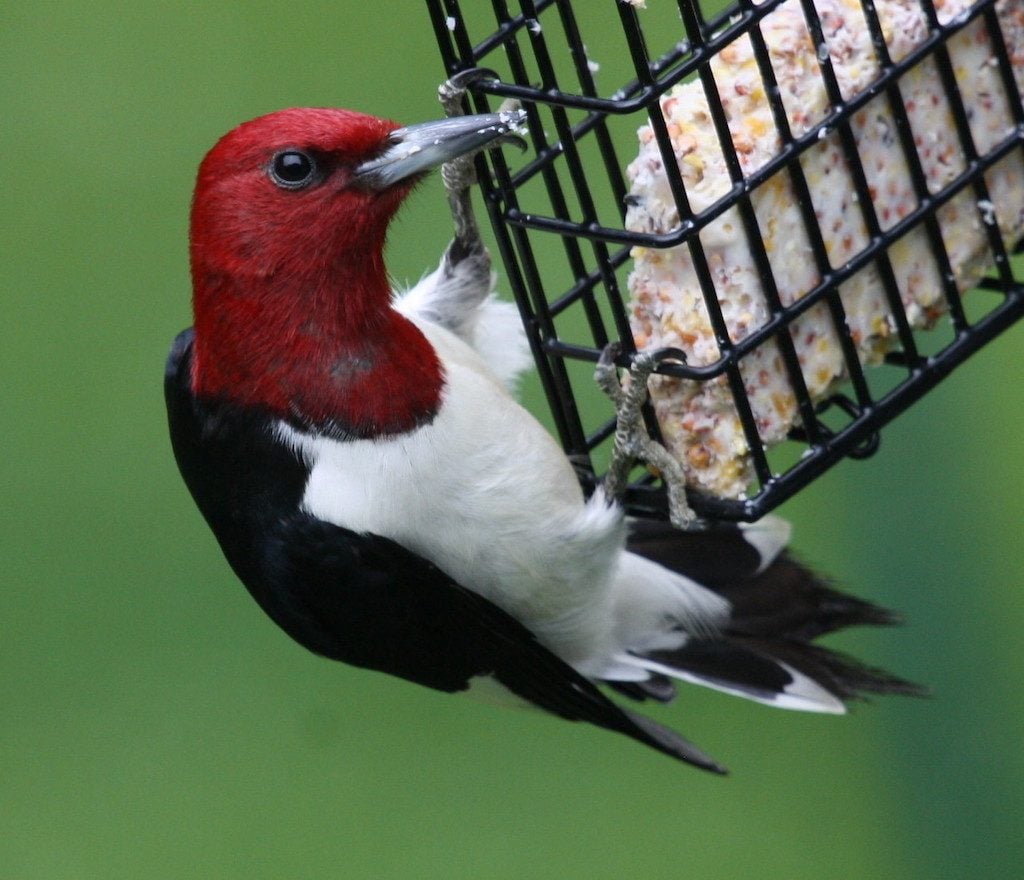
Among the brightest suet lovers on the block, red headed woodpeckers are medium-sized birds and flaunt a completely crimson head. They are most likely to visit feeders in winter and are drawn to oak, beech and other trees that produce nuts and seeds.
Check out the best foods for woodpeckers.
Canada Jay

Known as camp robbers because of their habit of nabbing food scraps from campsites, fluffy Canada jays are found in northern forests across the United States and are fearless and inquisitive. The robin-sized bird caches extra food in crevices to survive cold climates, and may even rear its chicks in winter.
Try out the best bird feeders for blue jays.
Northern Cardinal
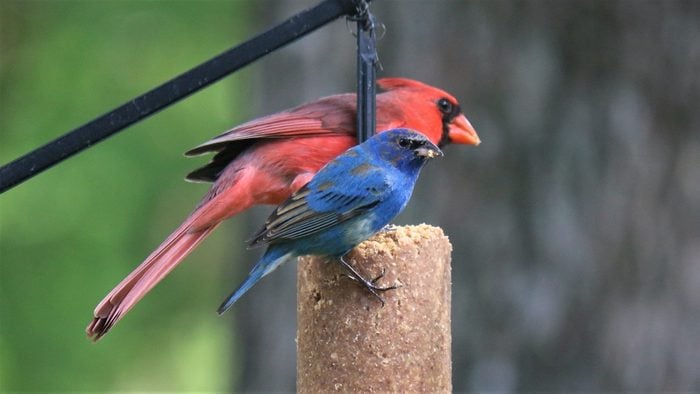
These sizable songbirds have short, thick bills, and both sexes have prominent crests. Bright red males and muted brown females are found in most areas east of the Rocky Mountains and parts of the Southwest. Cardinals often look as if they’re crouched over when sitting, pointing their tail feathers downward.
Follow these proven ways to attract northern cardinals.
Downy Woodpecker

The smallest woodpecker in North America, adult downies can weigh less than an ounce. Found across the country in open woodlands, deciduous woods and even the suburbs, these black-and-white checkered creatures are often members of mixed-species flocks.
Tufted Titmouse

This stout bird features a pointed crest, a rounded bill, large black eyes and a gray body. Spot titmice in the eastern U.S. near open tree canopies, city parks and backyards—and watch as they whack large seeds on hard surfaces.
Find out how to attract titmice to visit your backyard.
Brown Creeper

Blending into bark across the U.S., the brown and tan streaked creepers keep their white bellies hidden as they spiral upward around tree trunks. Smaller than a sparrow, brown creepers have slim frames, long tails with stiff tips, and slender, curved beaks. To attract them, smear suet on a tree trunk.
Red-Breasted Nuthatch

These compact creatures sport sharp features and short appendages. The plump blue-gray birds may appear to have almost no neck under their black and-white patterned heads. Find red-breasted nuthatches throughout the U.S. along tree limbs, creeping in all directions.
Ruby-Crowned Kinglet

Spot these tiny, energetic birds foraging in a frantic fashion through shrubs and trees across North America. At only 3 or 4 inches long, ruby-crowned kinglets are known for their minuscule green-gray frames, constantly flicking wings, and white eye rings and bars.
7. Will Other Wildlife Eat Suet?
Keep in mind that birds aren’t the only creatures that love suet. The strong-smelling fat in suet attracts mammals, so keep an eye out for local critters such as squirrels, raccoons, rats, skunks, deer or bears. Consider installing a baffle to deter smaller animals.
Here’s our best tips for squirrel-proof bird feeders.
8. Can You Feed Suet in Warm Weather?
Raw suet turns rancid quickly in warm weather. It melts when the temperature rises above 70 degrees and might stick to birds’ feathers. Gooey feathers are dangerous, so raw suet should be served only during the colder months. Cornmeal and peanut butter can also go rancid quicker, Ken says. He also warns that nut butters in high heat can be too sticky for birds’ beaks. Consider alternatives like no-melt suet nuggets or a peanut feeder.
Is it OK to add bacon fat to suet? Here’s what our experts say.
Where Do Bluebirds Migrate?
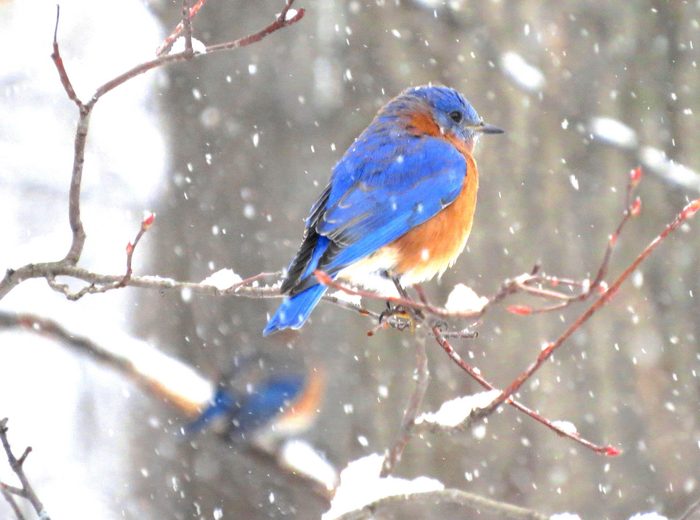
“Two pairs of eastern bluebirds moved into our purple martin house. Do bluebirds migrate? Shouldn’t they be heading south for the winter?” asks Ann Forth of Rockton, Ontario.
Kenn and Kimberly: Although many eastern bluebirds do migrate south in fall, others stay behind. Every winter, small flocks of bluebirds remain through the season in scattered areas all over southern Ontario. One of the keys to their survival is having secure places to sleep at night in cold weather, and it sounds as if the two pairs chose your martin house as their winter roost. Normally it’s a good idea to seal up the entrances to these houses until the martins return in spring, but of course it’s worthwhile to keep them open if bluebirds are using them.
Check out beautiful pictures of bluebirds and these adorable photos of baby bluebirds.
What Do Bluebirds Eat in Winter?
“A few winters ago, four bluebirds spent time in the nesting boxes in my yard. What do they eat during the cold months?” asks Thomas Bruce of Wayland, Michigan.
Many bluebirds do stay as far north as Michigan for the winter, although they’re found only in limited areas.
During the colder months they’ll eat mainly fruits and berries, so planting native trees and shrubs that bear fruit is a wonderful way to provide food. Wild fruits and berries make up the main part of their winter diet, so they favor areas where they can consume fruits of red cedar, dogwood, hackberry, sumac, wild grape, poison ivy and other plants.
Check out the best bluebird feeders and feeding tips.
You can put out mealworms for bluebirds, but the best methods involve foods in nature. Bluebirds feed heavily on insects they find on or near the ground, so avoid treating your lawn with chemicals. They also love bird baths, and if you can make the water move—even if you just add a small dripper—that’s better still.
In cold weather, they usually sleep in tree cavities or other holes, so they may have been using your nesting boxes to roost in at night. Learn the best place for a bluebird house.
Next, discover more tips for attracting bluebirds.

Can You Reuse Potting Soil?
“Can potting soil be reused, or does it need to be thrown away after a plant is removed?” asks Bob Nelson of Buffalo, New York.
Consider using fresh potting soil in your annual planters each year. This helps avoid future pest problems caused by insect or disease populations that may be building in the soil. Try composting the soil as well as the plant. Soil contains wonderful microorganisms that help with decomposition. It’s a great way to recycle potting mix back into the landscape.
Don’t use soil directly from the garden. As tempting as it is to dig up some backyard dirt and throw it into a container, potted plants need drainage. Use a high-quality potting mix or potting soil when planting containers. The best blends are designed to stay slightly moist while allowing excess water to drain. This keeps the mix light and airy so plants receive more oxygen. Look for potting mixes that have vermiculite, peat moss, compost and perlite.
If your container doesn’t have drainage holes on the bottom, drill a few holes yourself.
Check out the best potting soil for every type of plant.
Bugs in Potting Soil
“When I got out my pots from last fall, tons of little bugs with wings covered the old soil. Can I reuse the potting soil?” asks Suzanne Foote of Cayuga, New York.
In general it’s best not to save and reuse potting soil when the mix or plants are infested with insects or infected with disease. So discard that soil and clean the pots before you use them again.
If you don’t want to discard potting soil each year for container plants, there is a valid and affordable alternative. Simply work in a little compost from year to year to improve the soil structure and provide added nutrients. But if you’re growing a rare or cherished plant you’d hate to lose to disease, it’s worth the investment to change the potting soil annually.
Follow these 5 steps for preparing a garden for spring.
How to Clean Garden Planters
To clean your planters, dip each pot in a solution of 1 part bleach to 9 parts water. Then rinse the pots in clear water and they’ll be ready for fresh soil and new plants!
Next, check out easy plants you can grow in containers. Plus, here’s how to fertilize your plants the right way.
What Do Brown Headed Nuthatches Look Like?

The size, shape and plumage of the brown headed nuthatch is nearly identical to a pygmy nuthatch. Look for a brown cap, gray back and a pale throat. The best way to tell the difference between these birds is by their range. These small, short-tailed songbirds are very acrobatic and can hang upside down and walk up and down tree trunks. They measure about four inches long.
Brown Headed Nuthatch Nest

Like other nuthatches, the brown headed nuthatch nests in tree cavities. “I saw a pair of nuthatches carving their cavity nest in a dead branch of a Japanese cherry tree. So the next day I went out to try to capture this busy bird couple. I enjoy their size and energy, and it was a blast seeing them chip out this nest,” says Martin Bozone.
Psst—watch your fall feeders for a red breasted nuthatch.
Brown Headed Nuthatch Call
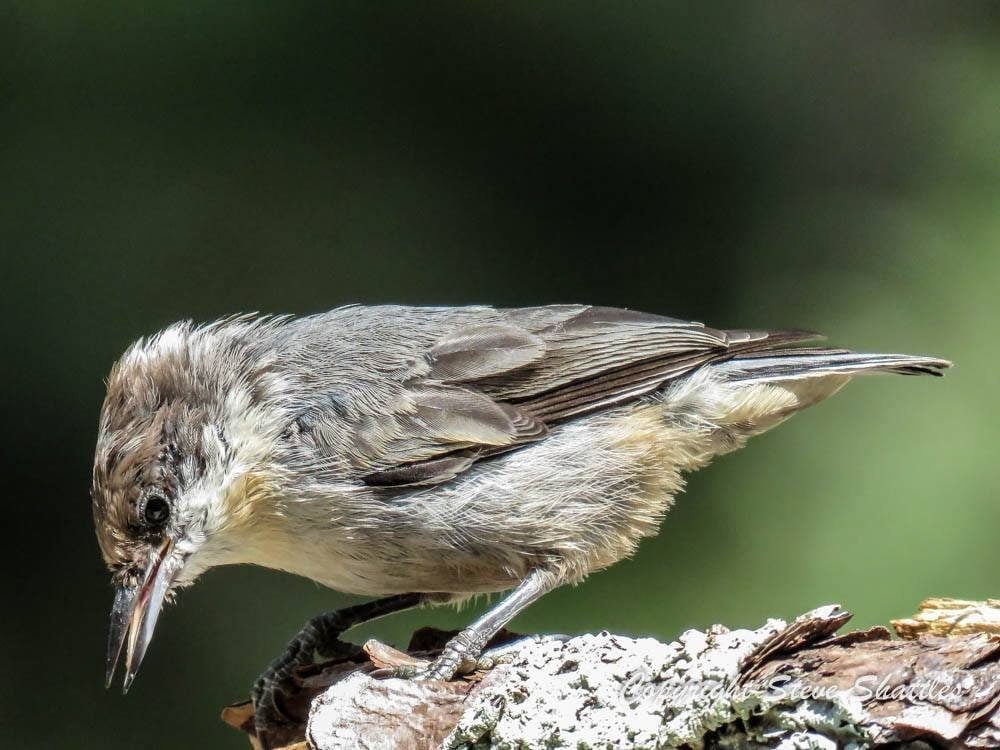
You may hear these talkative birds before you see them. The call of this nuthatch, ki-dee, sounds like a rubber duck squeaking.
Meet the white breasted nuthatch: the upside down bird.
What Do Brown Headed Nuthatches Eat?
Their diet mainly consists of insects and pine seeds. They may visit bird feeders for seeds, nuts and suet, but the best way to attract them is by planting native pine trees. “It’s a pleasure to spot brown headed nuthatches foraging among the pine needles and tree bark for seeds and insects. Very few birds use tools, but these nuthatches often pry bark up from a tree using another piece of bark to search for insects. They are active feeders, moving up, down and around trees very quickly, which means photographing them can be quite a challenge. Just watching them always brings a smile to my face,” says Michael Fitzgerald of Merritt Island, Florida.
Discover the 4 foods nuthatches love to eat.
Range and Habitat
According to the Kaufman Field Guide to Birds of North America, look for these brown headed nuthatches in the pine forests of the southeast, from eastern Texas to the Carolinas. They are nonmigratory in their range, travel in pairs or small groups, and often stay in the treetops.
Next, check out 15 common backyard birds you should know.
Chickadees and nuthatches are active songbirds that are commonly spotted in backyard trees. They flutter about, looking for insects to eat, and also frequently visit bird feeders. These small birds also nest in tree cavities. But despite the similarities, there are easy ways to identify these birds. Here’s how to tell the difference between a nuthatch vs a chickadee.
Nuthatch vs Chickadee

Nuthatches often walk headfirst down tree trunks and cling to bird feeders upside down. They have shorter tails and longer bills than chickadees. Nuthatches often cache bugs, seeds and nuts away in small crevices to find and eat later. The white-breasted nuthatch is the most common, and is widespread in forests, parks and backyards across the United States. They do not migrate, so you can see them year-round across their range. This species has a black cap, like a chickadee, but with a white face and throat, and a blueish gray back. You may see brown or orange coloring on their lower belly.

Red breasted nuthatches do migrate, so look for them at your feeders in fall and winter. They spend the breeding season farther north. Look for a white eyebrow and a black eye stripe, as well as a light orange chest and belly.
Other nuthatches you should know are the brown headed nuthatch, which resides in the Deep South, and the pygmy nuthatch that is found in the western states.
How to tell the difference: downy vs hairy woodpeckers.
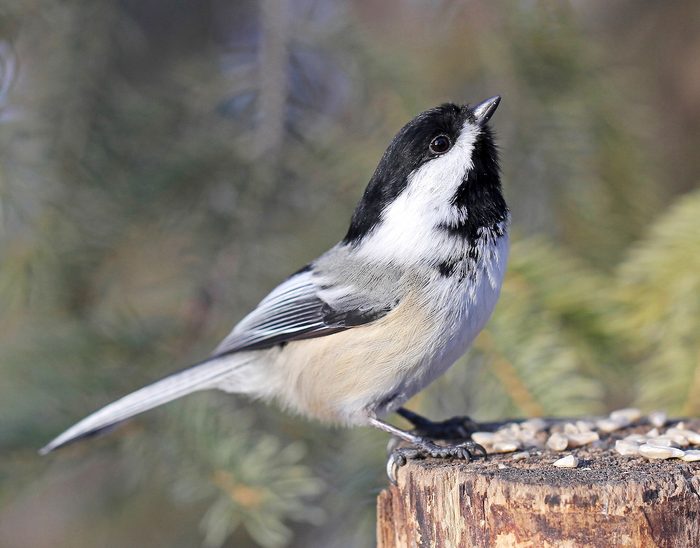
Black-capped chickadees have longer tails, a black cap and bib under their chin, and buff colored sides. These cute birds also have shorter bills than nuthatches. Listen for their distinctive “chick-a-dee-dee-dee” song. Carolina chickadees look very similar to their black-capped cousins and are very common birds across the southeastern states. The edge of their bib may appear neater.
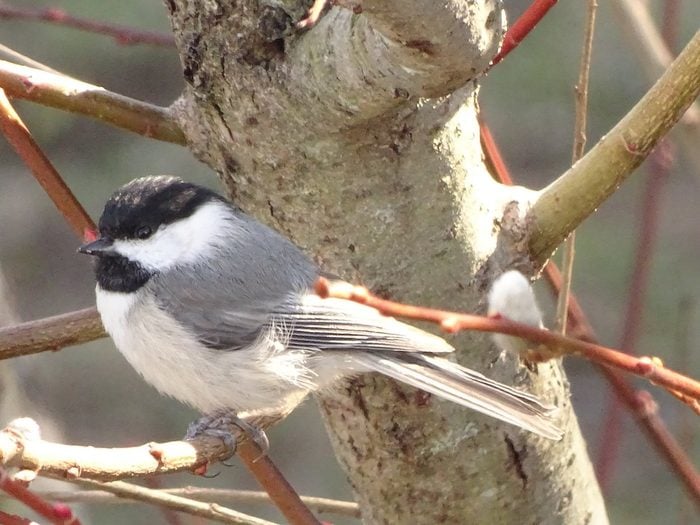
In the west, look for mountain chickadees, which have a white eyebrow on their black caps, and the more colorful chestnut-backed chickadees. Boreal chickadees, which feature a brown cap and plain brown sides, are residents of the far northern forests. Psst—baby chickadees are utterly adorable.
Next, learn the difference between European robins vs American robins.
